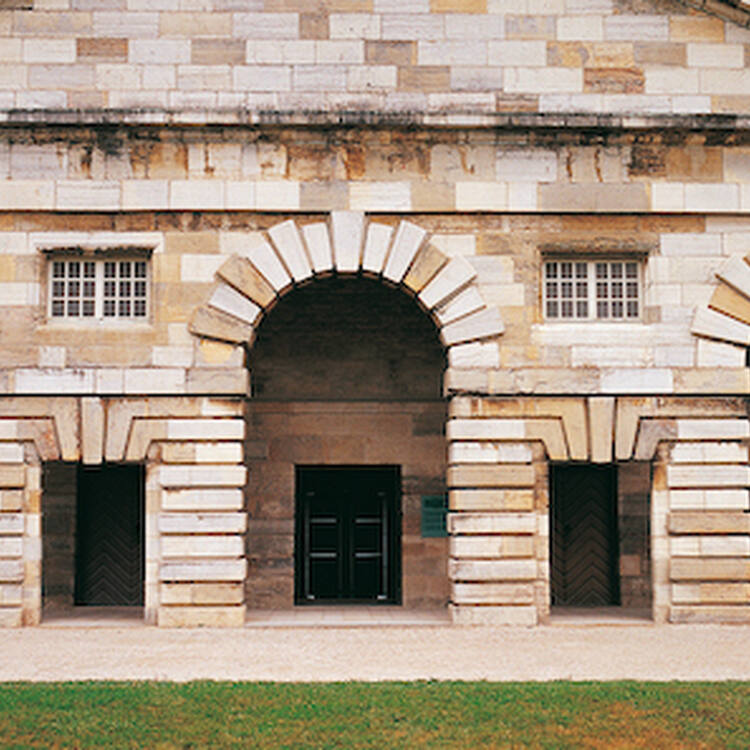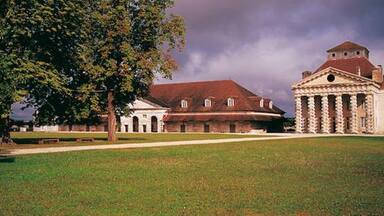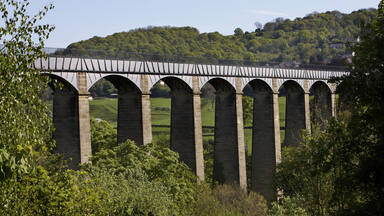From the Great Saltworks of Salins-les-Bains to the Royal Saltworks of Arc-et-Senans, the Production of Open-pan Salt
From the Great Saltworks of Salins-les-Bains to the Royal Saltworks of Arc-et-Senans, the Production of Open-pan Salt
The Royal Saltworks of Arc-et-Senans, near Besançon, was built by Claude Nicolas Ledoux. Its construction, begun in 1775 during the reign of Louis XVI, was the first major achievement of industrial architecture, reflecting the ideal of progress of the Enlightenment. The vast, semicircular complex was designed to permit a rational and hierarchical organization of work and was to have been followed by the building of an ideal city, a project that was never realized.
The Great Saltworks of Salins-les-Bains was active for at least 1200 years until stopping activity in 1962. From 1780 to 1895, its salt water travelled through 21 km of wood pipes to the Royal Saltworks of Arc-et-Senans. It was built near the immense Chaux Forest to ensure its supply of wood for fuel. The Saltworks of Salins shelters an underground gallery from the 13th century including a hydraulic pump from the 19th century that still functions. The boiler house demonstrates the difficulty of the saltworkers’ labour to collect the “White Gold”.
Description is available under license CC-BY-SA IGO 3.0
De la grande saline de Salins-les-Bains à la saline royale d’Arc-et-Senans, la production du sel ignigène
La Saline Royale d'Arc-et-Senans, à proximité de Besançon, est l'œuvre de Claude Nicolas Ledoux. Sa construction, qui débuta en 1775 sous le règne de Louis XVI, est la première grande réalisation d'architecture industrielle qui reflète l'idéal de progrès du siècle des Lumières. Ce vaste ouvrage semi circulaire fut conçu pour permettre une organisation rationnelle et hiérarchisée du travail. La construction initiale devait être suivie de l'édification d'une cité idéale, qui demeura à l'état de projet.
La Grande Saline de Salins-les-Bains fut en activité pendant 1200 ans, jusqu’en 1962. De 1780 à 1895, son eau salée a été acheminée sur une distance de 21km par des saumoducs jusqu’à la Saline Royale d’Arc-et-Senans, construite à proximité d’un massif forestier important pour en assurer le combustible. La Saline de Salins abrite une galerie souterraine du XIIIe siècle avec une pompe hydraulique du XIXe toujours en fonctionnement. La salle des Poêles laisse imaginer la pénibilité du travail des sauniers pour récolter l’Or Blanc.
Description is available under license CC-BY-SA IGO 3.0
الملاّحات الكبرى في سالان-له-بان
حيث كان يُستخرَج محلول الملح منذ القرون الوسطى إن لم نقل في عهد أقدم، تضم ثلاثة مبانٍ فوق سطح الأرض وهي: مستودعات الملح، ومبنى بئر آمونت، ومبنى للإقامة سابقا. والموقع ذو صلة بملاّحات كلود-نيكولا لْدو الملكية في آرك-إي-سينان، وهو شاهد على تاريخ استخراج الملح في فرنسا.
source: UNESCO/CPE
Description is available under license CC-BY-SA IGO 3.0
De la gran salina de Salins-les-Bains a la Salina Real de Arc-et-Senans - La producción de sal ignígena
Situada cerca de la ciudad de Besançon, la Salina Real de Arc-et-Senans es obra del arquitecto Claude-Nicolas Ledoux. Se empezó a construir en 1775, a principios del reinado de Luis XVI, y fue la primera realización importante de la arquitectura industrial en la que se patentizaron los ideales de progreso del Siglo de las Luces. El vasto conjunto arquitectónico semicircular del sitio fue diseñado para facilitar una organización racional y jerarquizada del trabajo. La ciudad ideal que se había planeado construir inmediatamente después no llegó a materializarse nunca. La Gran Salina de Salins-les-Bains, de donde se extrae sal desde la Edad Media o incluso antes, incluye tres edificios: los almacenes de sal, el edificio del pozo de Amont y una antigua vivienda. El sitio es un testimonio de la historia de la extracción de sal en Francia.
source: UNESCO/CPE
Description is available under license CC-BY-SA IGO 3.0
天日製塩施設、サラン‐レ‐バン大製塩所からアルケ‐スナン王立製塩所まで
source: NFUAJ
Grote zoutmijn van Salins-les-Bains en koninklijke zoutmijn van Arc-et-Senans - de productie van open pan-zout
Source: unesco.nl
Outstanding Universal Value
Brief synthesis
The saltworks in Salins-les-Bains and Arc-et-Senans demonstrate outstanding universal value in terms of the extent of the chronological timeframe during which the extraction of salt continued in Salins, certainly from the Middle Ages, and probably from prehistoric times, through to the 20th century. Spa activity has extended its use until nowadays. The saltworks also demonstrate outstanding universal value in terms of the specific nature of salt production in Salins-les-Bains and Arc-et-Senans, based on a technique of tapping sources of salt deep underground, the use of fire to evaporate the brine, and the 18th century innovation of the creation of a 21km pipeline to carry the brine between the two sites. The saltworks express their value as well for the exceptional architectural quality of the Royal Saltworks of Arc-et-Senans and its participation in the movement of ideas in the Age of Enlightenment. It is testimony to a visionary architectural project of a ‘model factory.’ Developed and built by the architect and supervisor of saltworks in Franche-Comté and Lorraine, Claude-Nicolas Ledoux (1736–1806), Arc-et-Senans is the modern and Utopian extension of the Great Saltworks of Salins-les-Bains.
Criterion (i): The Royal Saltworks at Arc-et-Senans is the first architectural complex on this scale and of this standard designed as a place of work. This is the first instance of a factory being built with the same care and concern for architectural quality as a palace or an important religious building. It is one of the rare examples of visionary architecture. The Saltworks was the heart of an Ideal City which Claude-Nicolas Ledoux imagined and designed encircling the factory. The unfinished Utopian architecture of the Saltworks still carries the full impact of its futuristic message.
Criterion (ii): The Royal Saltworks of Arc-et-Senans bears witness to a fundamental cultural change in Europe at the end of the 18th century: the birth of industrial society. Besides being a perfect illustration of an entire philosophical current that swept Europe during the Age of Enlightenment, the Royal Saltworks heralded the industrial architecture that was to develop half a century later.
Criterion (iv): The saltworks of Salins-les-Bains and Arc-et-Senans provide an outstanding technical ensemble for the extraction and production of salt by pumping underground brine and the use of fire for its crystallisation, since at least the Middle Ages through to the 20th century.
Integrity and authenticity
So far as its industrial and technical integrity is concerned, the historical enclosure of Salins-les-Bains is conserved as a distinct land area. The pumping installations and part of the saline water treatment structures (stoves) retain their integrity. The remaining above-ground buildings have been restored but without any alteration to their volume.
Changes over time mean that only fragments of the medieval complex remain, but the system governing the rapport between the production complex, the town, and the surrounding territory seems to have retained sufficient integrity. However, the disappearance of almost all the surrounding wall, leaving just the former entrance gate standing by itself, has broken down the separation between the saltworks and the urban fabric. Similarly, the new casino undermines the integrity of the site of the Great Saltworks because of its architecture and its location in the heart of the property. The remains of the Great Saltworks of Salins-les-Bains are authentic, notably those relating to the old pumps and brine treatment, and testimonies that are very rare in Europe. The modernist constructions added for the museum and the casino have respected the authenticity of the archaeological remains and the residual old buildings.
Protection and management requirements
The management system of the property is adequate; it has recently been institutionalized with a joint management authority and the guarantee of a management plan being implemented.


